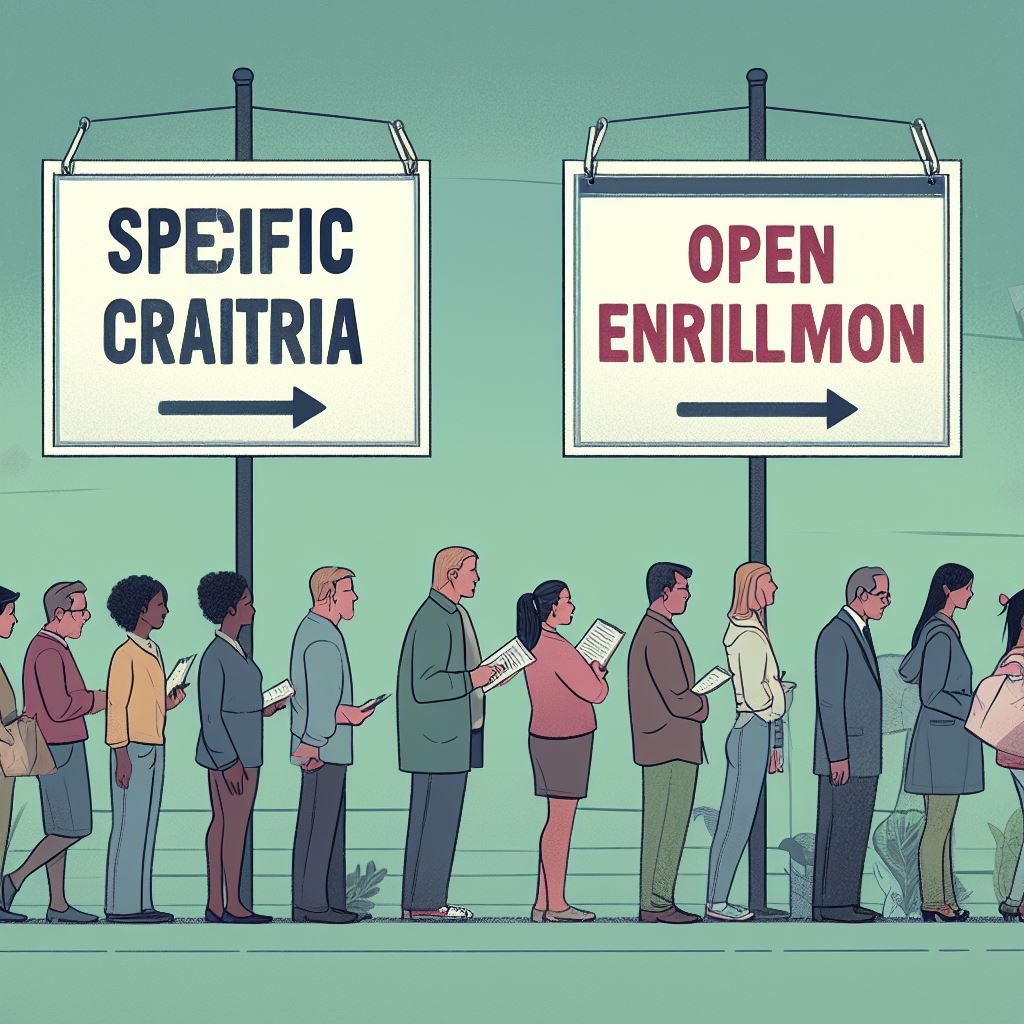Why Are Specific Criteria Essential for Open Enrollment?

Are you ready to navigate the open enrollment process with ease?
Discover why specific criteria are essential for a successful enrollment experience. Streamline your selection process, avoid overwhelm and confusion, and ensure adequate coverage.
By maximizing cost-effectiveness and making informed decisions, you can empower yourself to choose the best options for you.
Get ready to dive into the world of open enrollment, where clarity and confidence await.
Key Takeaways
- Specific criteria for evaluating candidates during open enrollment helps streamline the selection process.
- Clearly defined criteria and qualifications prevent overwhelm and confusion among employees and administrators.
- Adequate coverage can be ensured by carefully reviewing and evaluating healthcare options and needs.
- Cost-effectiveness can be maximized by comparing premiums, deductibles, and in-network providers.
Streamline the Selection Process
Streamline your selection process by implementing specific criteria that will help you efficiently evaluate and choose the best candidates during open enrollment. Developing clear and concise criteria will enable you to assess applicants objectively, ensuring that you make informed decisions.
To begin, identify the key qualifications and skills required for the positions you’re hiring for. Clearly define the education, experience, and certifications necessary for each role. This will allow you to focus your evaluation on those candidates who meet the minimum requirements.
Next, establish performance metrics and benchmarks that align with your company’s goals and values. These criteria will help you assess candidates’ potential for success in your organization. Consider factors such as past achievements, problem-solving abilities, and cultural fit.
Additionally, it’s crucial to communicate the selection criteria to all stakeholders involved in the hiring process. This will ensure that everyone is on the same page and understands the qualities and qualifications that are being sought.
Avoid Overwhelm and Confusion
To avoid overwhelm and confusion, you need to clearly define and communicate the specific criteria for open enrollment. Open enrollment is a critical period for employees or individuals to select their benefits or insurance plans. Without clear criteria, the process can become chaotic and lead to misunderstandings.
Here are three reasons why defining specific criteria is essential:
- Clarity: By clearly outlining the eligibility requirements, deadlines, and available options, individuals can easily understand what they need to do during the open enrollment period. This eliminates confusion and ensures that everyone is on the same page.
- Efficiency: When specific criteria are established, individuals can quickly assess their eligibility and make informed decisions. This streamlines the selection process and saves time for both employees and administrators.
- Fairness: Clearly defined criteria ensure that everyone has an equal opportunity to participate in open enrollment. It prevents favoritism or bias and promotes transparency and fairness throughout the process.
Ensure Adequate Coverage
Make sure you have adequate coverage during open enrollment by carefully reviewing your options and selecting the best plan for your needs. Adequate coverage is essential to ensure that you have access to the healthcare services you require without incurring excessive costs. During open enrollment, it’s crucial to assess your healthcare needs and consider factors such as your budget, medical history, and anticipated healthcare expenses.
To ensure adequate coverage, start by evaluating the different plans available to you. Compare the coverage options, including medical, dental, and vision benefits, as well as prescription drug coverage. Consider whether the plan includes your preferred healthcare providers or if you’ll need to switch doctors. Additionally, assess the plan’s network of hospitals and specialists to ensure you have access to the necessary healthcare facilities.
While reviewing your options, pay close attention to the plan’s deductible, copayments, and out-of-pocket maximums. These factors determine how much you’ll need to pay for healthcare services. If you anticipate needing frequent medical care or have ongoing medical conditions, a plan with lower out-of-pocket costs may be more suitable.
In conclusion, selecting a plan that provides adequate coverage is crucial during open enrollment. By carefully reviewing your options and considering your healthcare needs, you can ensure that you have the appropriate coverage in place.
The next section will explore how to maximize cost-effectiveness during open enrollment.
Maximize Cost-Effectiveness
To maximize cost-effectiveness during open enrollment, carefully compare the premiums and benefits of different plans to find the most affordable option that meets your healthcare needs. Open enrollment is a critical time to assess your healthcare options and ensure you’re getting the most value for your money.
Here are three important factors to consider when maximizing cost-effectiveness:
- Premiums: Compare the monthly premiums of different plans. Premiums are the amount you pay each month for insurance coverage. Look for a plan with a lower premium that still provides the necessary coverage for your healthcare needs.
- Deductibles and Copayments: Consider the deductibles and copayments associated with each plan. Deductibles are the amount you must pay before your insurance kicks in, and copayments are the fixed amount you pay for each visit or service. Find a plan with reasonable deductibles and copayments that align with your budget.
- Network Coverage: Check if your preferred doctors, hospitals, and specialists are in-network for the plan you’re considering. In-network providers typically have negotiated rates with your insurance company, which can result in lower out-of-pocket costs for you.
Make Informed and Empowered Decisions
By actively researching and comparing your options, you can make informed and empowered decisions during open enrollment. It is crucial to understand the various plans available to you and how they align with your specific needs and preferences. This will ensure that you choose the best coverage that meets your healthcare requirements while maximizing your benefits and minimizing costs.
To help you evaluate your options, consider the following table:
| Plan Name | Coverage | Cost | Benefits |
|---|---|---|---|
| Plan A | Comprehensive | High | Extensive |
| Plan B | Basic | Low | Limited |
| Plan C | Mid-level | Medium | Moderate |
| Plan D | High-deductible | Low | Customizable |
This table provides a visual representation of the different plans available, highlighting their coverage, cost, and benefits. By comparing these factors, you can make an informed decision that aligns with your healthcare needs and financial situation. It’s important to consider your current health status, any ongoing medical conditions, and your anticipated healthcare expenses when choosing a plan. Additionally, consider factors such as network coverage, prescription drug coverage, and flexibility in selecting healthcare providers.
Frequently Asked Questions
How Do Open Enrollment Criteria Streamline the Selection Process?
Open enrollment criteria streamline the selection process by providing clear guidelines for eligibility. They help to filter out ineligible candidates, ensuring that only qualified individuals can participate in the enrollment process.
What Strategies Can Be Implemented to Avoid Overwhelm and Confusion During the Open Enrollment Period?
To avoid overwhelm and confusion during open enrollment, you can implement strategies like providing clear communication, offering educational resources, and offering assistance through a dedicated support line.
Why Is It Important for Open Enrollment Criteria to Ensure Adequate Coverage?
To ensure you have the right coverage, it’s important for open enrollment criteria to be specific. Without it, you could end up without adequate coverage, leaving you vulnerable in times of need.
How Can Open Enrollment Criteria Maximize Cost-Effectiveness for Individuals or Organizations?
To maximize cost-effectiveness during open enrollment, specific criteria are essential. By ensuring that individuals or organizations meet certain requirements, resources can be allocated more efficiently, resulting in better coverage and reduced expenses.
What Resources Are Available to Help Individuals Make Informed and Empowered Decisions During Open Enrollment?
When making decisions during open enrollment, you need resources to be informed and empowered. Websites like Healthcare.gov offer tools to compare plans, estimate costs, and understand coverage options. Use them to your advantage.



